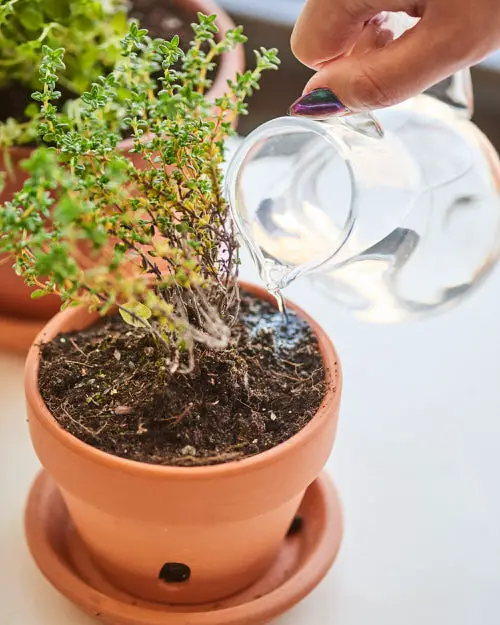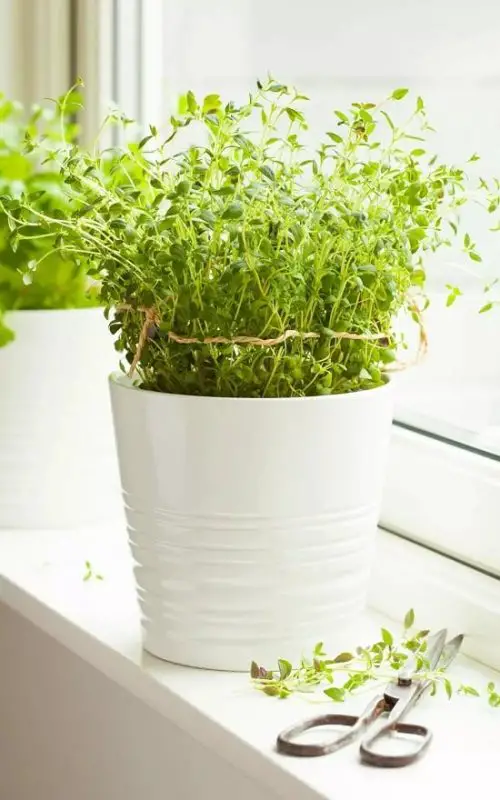These potent Thyme Growing Tips will help you to grow and harvest this herb with the most flavorful leaves!

Thyme is an aromatic and evergreen plant that produces white, purple, and pink flowers. Be it Italian seasoning or bouquet garni; thyme is an essential part of many cuisines! To ensure that you always have a fresh supply of this versatile herb, we bring you some great Thyme Growing Tips!
Check out our article on growing an Italian herb garden here!
Why Should you Grow Thyme?
If thyme is your favorite cooking herb, you should be growing it! Thyme has the power to raise the taste quotient of any cuisine you add it to!
Just try roasting it with potatoes! The cooking aroma will make you drool over the dish. Add it to vegetables and seafood to instantly boost the flavor.
And did we say adding its tangy taste to stews makes them taste great? How about sprinkling dried thyme while baking bread? It’s going to taste yummy with butter! You indeed have more than enough reasons to grow thyme right away!
Best Varieties of Thyme
The most common types are French, Lemon, and Caraway. Some of the most popular varieties are:
- Archers Gold – It is pretty popular, thanks to the variegated foliage and lemon fragrance. They are used widely in poultry and fish dishes. It grows up to 10-12 inches tall with a similar spread.
- Variegata – It is a variegated variety with large leaves and pink flowers. The plant grows 8-12 inches tall with a 6-8 inches spread. It goes well with fish recipes.
- Mother of Thyme – It gives out a minty aroma when crushed and used in salads and teas. The plant grows 3-4 inches in height with 20-30 inches of spread.
- Common Thyme – This thyme is famous for its uses in seasoning meats and soups. It grows up to 6-10 inches tall with an 8-10 inches spread.
Here are some of the best Japanese herbs you can grow!
Super Thyme Growing Tips
1. Where to Grow
Thyme loves to grow in full sun but doesn’t mind partial shade either. So, keeping the plant at a location where it receives bright, direct light will be beneficial! It does well both in pots and on the ground. As rosemary and thyme, both have identical growing needs, you can pair them together.
When: Plant it in spring or anytime afterward when the weather becomes warm. Thyme can grow year-round as an evergreen herb in moderate climates.
2. How to Propagate
The best time to grow thyme with seeds is 3 to 4 weeks before the last frost date in your area. It’s always a good idea to grow it from cuttings and save yourself from seed sowing hassles. You can also buy a plant from a nursery or garden center.
You can also grow thyme from division by separating the entire plant from the pot and breaking it into sections. As it is a small specimen, take 2-3 divisions and plant them in separate pots filled with a seed starting mix.
For growing it with cuttings, snip 3-4 inches of stems. Apply rooting hormone and plant it in a 6-10 inches pot in well-draining soil. Water well, making sure that you are not making it soggy. The roots are going to emerge in 6-7 weeks.
3. Type of Soil to Use

Thyme prefers well-draining soil with a pH ranging between 6.0 to 6.7. Avoid adding too much organic matter to the growing medium as it will make the plant bushier, but it will take away the flavor.
4. Exposure to Light
To grow well, thyme needs plentiful light, about 5-6 hours daily. If you are growing it indoors, a south-facing window will be the best place! Find an area that receives full sun and place the pot there.
Tip: If you’re growing thyme in a hot climate, it’s better to avoid exposure to afternoon sunlight.
5. Watering it Right
Water the plants deeply when the soil is a bit dry. You will have to be a little more cautious when the plant is young, i.e., taking care of the moisture in the soil to ensure it never goes dry completely.
Once the plant establishes itself and grows about 4-6 inches tall, make sure to water it only when the topsoil feels dry to touch. Overwatering will result in wilting of leaves.
6. Space the Plants Perfectly
If you grow 2-3 plants together in different pots, place them at least 8-12 inches apart. Thyme is a vigorous grower and spreads quickly.
7. Use the Right Fertilizer
Thyme plants are not heavy feeders. Applying a slow-release, balanced fertilizer or aged manure will do just fine at the beginning of the growing season.
Depending on the growth, you can feed it with half-strength, balanced liquid fertilizers like 10-10-10 every 5-6 weeks. Keep in mind that it is not mandatory to fertilize thyme.
Feeding it too much will result in fewer essential oils, robbing the plant of its signature taste.
8. Take Care of Pests and Diseases

Be careful of whiteflies, scale, mealybugs, and spider mites, significantly when you are growing it indoors. Space the plants well and provide ample air circulation. For humid regions, look out for powdery mildew.
9. Best Pot Size For Growing Thyme
Do not go for overly large pots for growing thyme. A container of 6-8 inches will be just fine. It will also fit on a windowsill!
10. Companion Plants for Thyme
Grow this herb with eggplant, potatoes, strawberries, hyssop, garlic, chives, rosemary, and tomatoes. Thyme’s fragrances overpower the scent of these plants and keep the pests away.
Check out the best partial shade herbs here
Harvesting Thyme
To get the most flavor, harvest thyme just before it flowers for the best flavor and taste. Clip it in the morning after the dew has dried. The best part is that the more you harvest the plant, the more it will come back!
Do not take more than 25-35 percent of the overall plant at one time. Also, do not store the leaves as they taste best when fresh.
Health Benefits of Thyme
Thyme essential oil, extracted from its leaves, is a natural cough remedy. It is rich in vitamins A and C, known to boost immunity. Thyme’s essential oil has fungicidal properties. It is also an excellent organic approach to deter pests!




Hello, you used to write magnificent, but the last few posts have been kinda boring… I miss your tremendous writings. Past several posts are just a little bit out of track! come on!
I’m very much impressed with the advice as I’m still newin planting but very much interested keep on helping